| Article ID | Journal | Published Year | Pages | File Type |
|---|---|---|---|---|
| 66505 | Journal of Molecular Catalysis A: Chemical | 2011 | 6 Pages |
The catalytic oxidation of NO to NO2 (NO-COX) and the selective catalytic reduction of NO to N2 by methane in the presence of excess oxygen (NO-SCR) was studied over zeolite In,H-, Co,H-, and Co,In,H-ZSM-5 catalysts. The catalysts were characterized by temperature-programmed H2 reduction (H2-TPR) and operando DRIFT spectroscopy. The cobalt was present in the catalysts predominantly in Co-oxide clusters, whereas the charge of the zeolite framework was balanced by H+ and cationic indium species. The Brønsted acid sites promoted the NO-COX reaction; however, the Co-oxide clusters were much more active in this reaction. In absence of indium the catalysts were inactive in the NO-SCR reaction. The NO/NO2 mixture formed in the NO-COX reaction was shown to further react with the InO+/(InOH)2+-zeolite resulting in the simultaneous formation of InNO3 and NO+ species. The Co-oxide clusters increased the rate of NO2 generation and, thereby, the InNO3/NO+ formation. It was substantiated that an N-containing organic intermediate was obtained in the reaction of methane and nitrate group. Nitrogen was generated in the reaction between the obtained intermediate and the NO+. The catalytic cycle must have been closed by the oxidation of In+ to InO+/(InOH)2+ by the reactant mixture.
Graphical abstract.Figure optionsDownload full-size imageDownload high-quality image (207 K)Download as PowerPoint slideHighlights► InO+/In+ redox couple is the NO-SCR active site of In,H-zeolites. ► Methane is activated for NO-SCR over zeolite-bound NO+ and NO3− surface intermediates. ► Surface intermediates are formed in reaction of NO/NO2 and In,H-zeolite. ► Zeolite Brønsted acid sites promote NO/NO2 formation from NO/O2 (NO-COX reaction) ► Co-oxide additive enhances the NO-COX activity of H- and In, H-zeolite catalysts.
